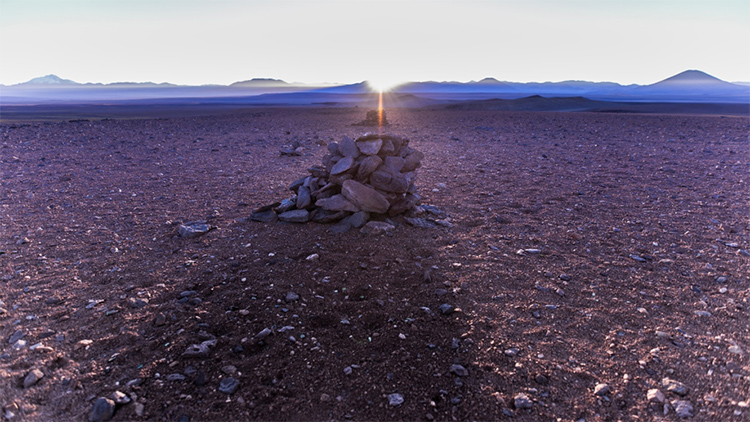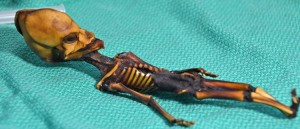Chile’s Ancient Desert Calendar
Wednesday, September 12th, 2018September 12, 2018
High in the Atacama Desert of Chile, a system of stone pillars and rock piles called saywas was recently found to be an ancient Inca calendar. Once thought only to mark a local Inca trail, a team of archaeologists, astronomers, historians, and researchers recently showed how the saywas work as a complicated and connected calendar to identify and predict equinoxes, solstices, and other astronomical events. The Inca trail in the Atacama Desert is part of the Qhapaq Ñan, an extensive Inca road network that stretches from southern Colombia to central Chile.

The sun peeks over the Andes Mountains at dawn, illuminating a line of ancient Inca saywas in the Atacama Desert of northern Chile. Credit: A. Silber, ALMA/ESO/NAOJ/NRAO
Working at 13,800 feet (4,200 meters) above sea level in the desert mountains near Taltal, a small city in northern Chile, the scientific team began visiting the saywas and taking measurements in 2017. The team included local indigenous people as well as experts from the Chilean Museum of Pre-Colombian Art, the nearby Atacama Large Millimeter/submillimeter Array (ALMA) observatory, and the European Southern Observatory. The research was funded by BHP/Minera Escondida, a mining company with more material interests in the desert.
The scientific team began the study by documenting alignments between certain saywas and the sunrises on the March equinox and June solstice. They then began connecting saywa points with other important dates on the ancient Inca calendar. Operating much in the same way as Stonehenge in England, the saywas align with sunrises on certain dates, while also projecting shadows on the ground that lead to other stone points. The researchers also found that certain saywas align with constellations at night, further strengthening the researchers’ conclusion, published in 2018, that the network of stones served as a large calendar for Inca astronomers.
The first written accounts of the saywas were recorded during the Spanish conquest of Andean South America in the 1500′s and 1600′s. The saywas’ remote locations in the empty desert, far from Inca cities, led the Spanish to believe that the stone piles were little more than pathway markers to help guide people through the vast, barren desert. The saywas did in fact aid in navigation, but the larger purpose of the stone markers remained unknown for centuries. In recent years, however, knowledge of the Inca has greatly expanded, and the study of ancient Quechua and Aymara (Inca languages) dictionaries led to the examination of the relationship between the saywas and the Inca astronomical system.
The ancient Inca capital of Cusco (in modern-day Peru) was surrounded by columns used to measure time, create calendars, and predict equinoxes and solstices as well as the planting and harvesting seasons. The remote saywas, however, were tucked away in the Atacama Desert. Perhaps that was merely the best view of the heavens, allowing Inca astronomers to get the most accurate measurements while Cusco was obscured by clouds and mist. Modern astronomers use the high desert for the same purpose. The sprawling ALMA observatory is only a (figurative) stone’s throw away.



